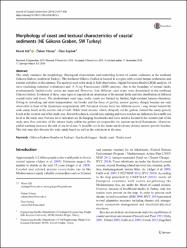| dc.contributor.author | Yılmaz Aksoy, Özlem | |
| dc.contributor.author | Zeybek, Özer | |
| dc.date.accessioned | 2020-11-20T14:42:19Z | |
| dc.date.available | 2020-11-20T14:42:19Z | |
| dc.date.issued | 2019 | |
| dc.identifier.issn | 1400-0350 | |
| dc.identifier.issn | 1874-7841 | |
| dc.identifier.uri | https://doi.org/10.1007/s11852-018-0672-3 | |
| dc.identifier.uri | https://hdl.handle.net/20.500.12809/1054 | |
| dc.description | Gul, Murat/0000-0003-1555-6426; | en_US |
| dc.description | WOS: 000462211600011 | en_US |
| dc.description.abstract | This study examines the morphology, lithological characteristic and controlling factors of coastal sediments in the northeast Gokova Graben (southwest Turkey). The northeast Gokova Graben is located in a region with several human settlements and tourism activities, in the summer. The analysis used in the study is field observation, Digital Elevation Model (DEM) analysis, 18 sieve (including statistical evaluations) and 18 X-ray Fluorescence (XRF) analyses. Due to the boundary of normal faults, predominantly faulted-rocky coasts are expected. However, four different coast types were determined in the northeast Gokova Graben. Evolution of these coast types is dependent on orientation of the normal faults and also distribution of different coastal rocks and rivers. The predominant coast type, rocky coasts are formed by faulted, high-resistant Jurassic-limestone. Owing to reworking and short transportation via brooks and the force of gravity, narrow gravely shingle beaches are only observable in front of the Quaternary-conglomerate cliff. Perennial streams form two different coasts. Long stream formed the wide sandy beach in the eastern end of Gulf. While short streams, which obliquely cut the graben, formed the sandy-gravely beach at the western end of the study area. Recent beachrock, coastal rock staining and wave notches are indicators for a stable sea level in the study area. Past sea level indicators are the hanging beachrocks and wave notches located in the western part of the study area. Past activities of the interior faults within the graben are responsible for ancient sea level fluctuations. Moreover, global warming increases the risk of sea level rise. A possible rise in the future sea-level may destroy narrow-gravely beaches. This risk may also threaten the wide sandy beach as well as the settlement in the area. | en_US |
| dc.description.sponsorship | Mugla Sitki Kocman University, Scientific Research FundMugla Sitki Kocman University [BAP 10/20] | en_US |
| dc.description.sponsorship | This study was funded by the Mugla Sitki Kocman University, Scientific Research Fund, BAP 10/20. | en_US |
| dc.item-language.iso | eng | en_US |
| dc.publisher | Springer | en_US |
| dc.item-rights | info:eu-repo/semantics/openAccess | en_US |
| dc.subject | Gokova Graben (Southwest Turkey) | en_US |
| dc.subject | Sea Level Changes | en_US |
| dc.subject | Sandy Coast | en_US |
| dc.subject | Rocky Coast | en_US |
| dc.title | Morphology of coast and textural characteristics of coastal sediments (NE Gokova Graben, SW Turkey) | en_US |
| dc.item-type | article | en_US |
| dc.contributor.department | MÜ, Mühendislik Fakültesi, Jeoloji Mühendisliği Bölümü | en_US |
| dc.contributor.departmentTemp | Gül, Murat | |
| dc.contributor.institutionauthor | Gül, Murat | |
| dc.contributor.institutionauthor | Yılmaz Aksoy, Özlem | |
| dc.contributor.institutionauthor | Zeybek, Özer | |
| dc.identifier.doi | 10.1007/s11852-018-0672-3 | |
| dc.identifier.volume | 23 | en_US |
| dc.identifier.issue | 2 | en_US |
| dc.identifier.startpage | 417 | en_US |
| dc.identifier.endpage | 434 | en_US |
| dc.relation.journal | Journal of Coastal Conservation | en_US |
| dc.relation.publicationcategory | Makale - Uluslararası Hakemli Dergi - Kurum Öğretim Elemanı | en_US |


















